Brazilian Tapioca Crepes are a popular street food with indigenous roots from my Northeast region in Brazil. You can prepare them quickly with tapioca flour, water or juice, and salt, making a cheap breakfast, vegan snack, or gluten-free lunch or dinner.
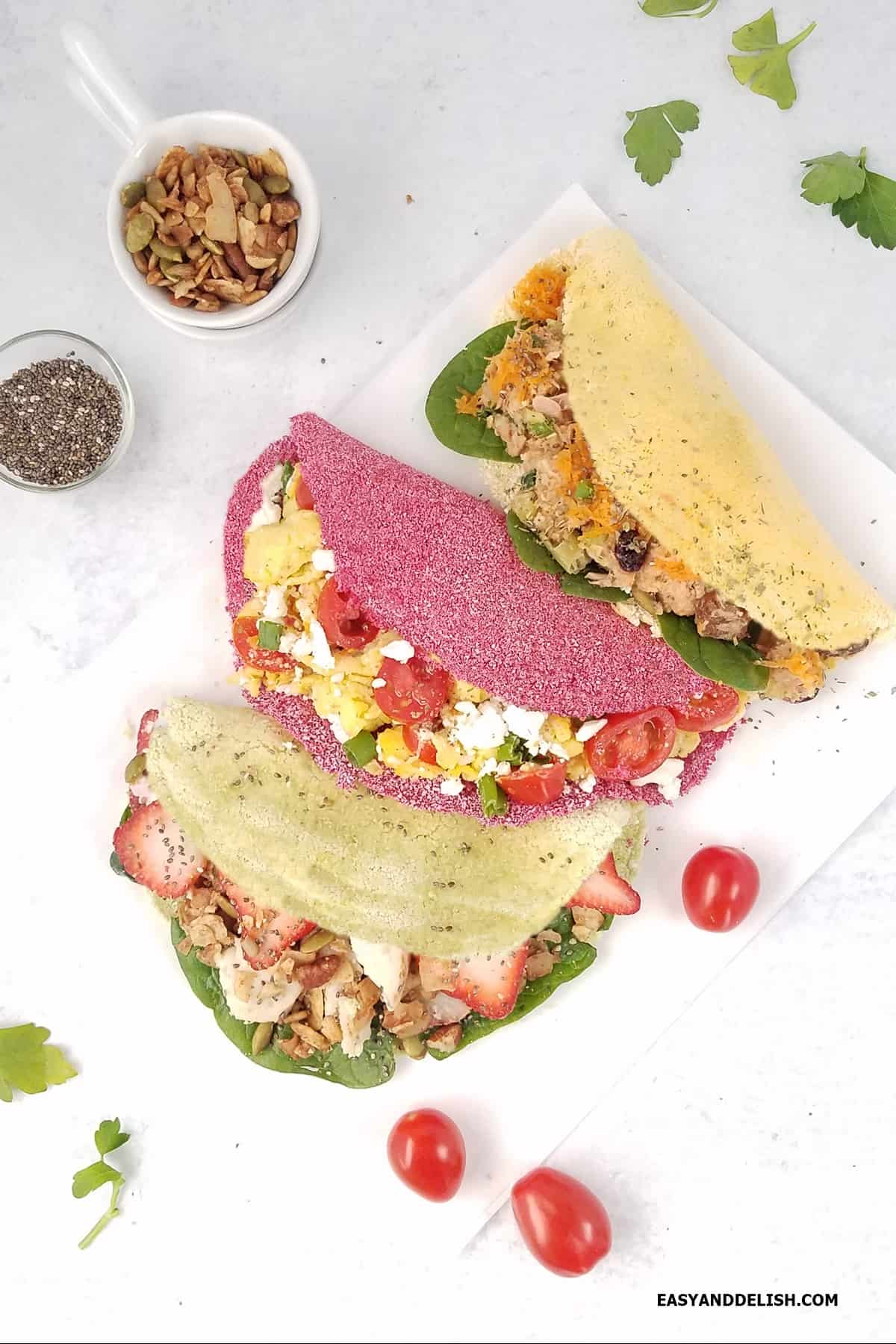
Table of Contents
How to Make Brazilian Tapioca
- Prepare the juice to color the tapioca crepes: In a blender, blend one of the vegetables (spinach, beets, or carrots) with water until smooth.
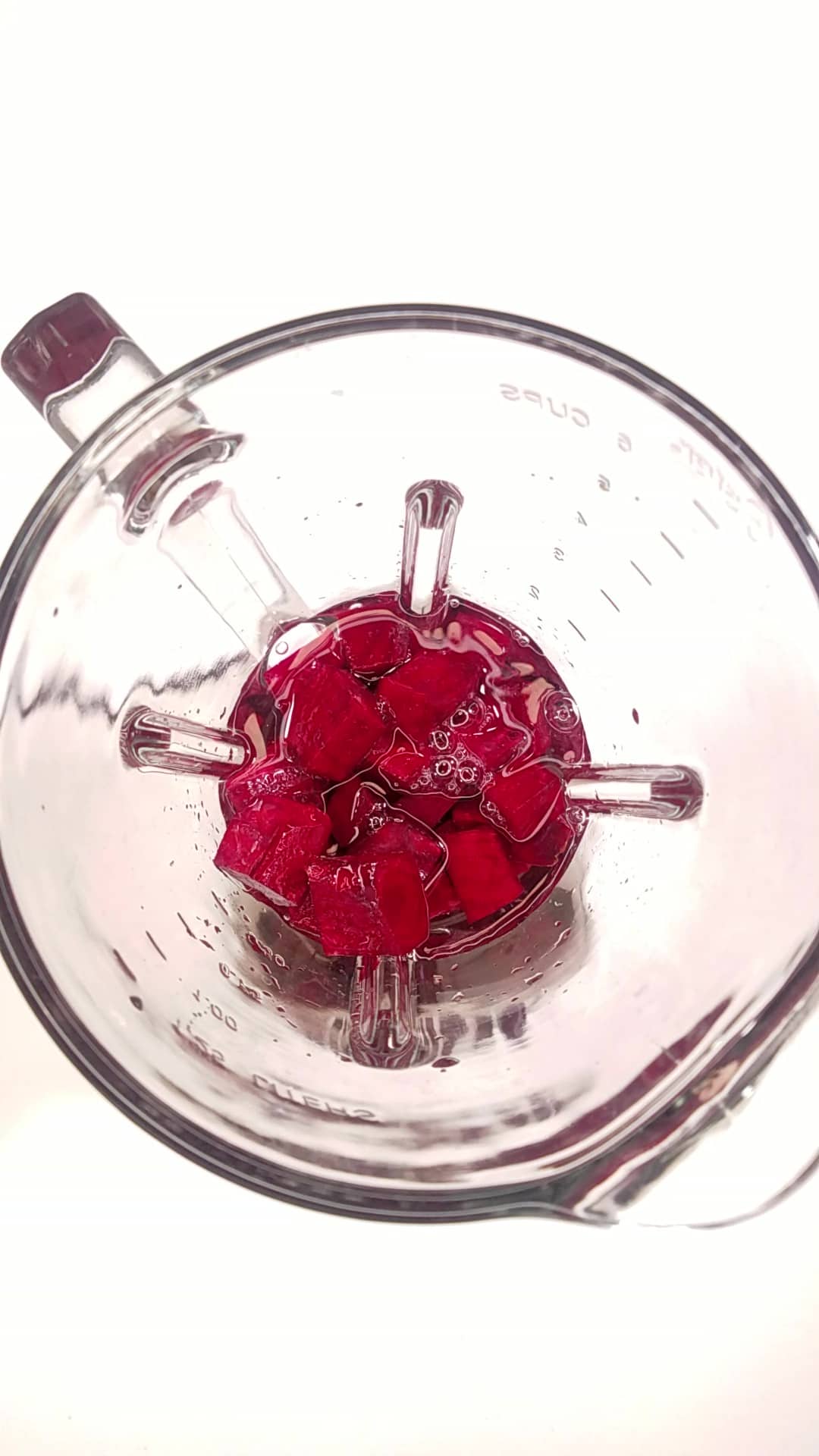
- Using a fine-mesh sieve, strain the liquid and discard the pulp (or use it to make something else). Reserve the strained juice. NOTE: If you prefer to prepare the most common type of tapioca which is white, simply use water instead of juice. The vegetable juices won't flavor the crepes. They only color the tapioca flour with natural food coloring.
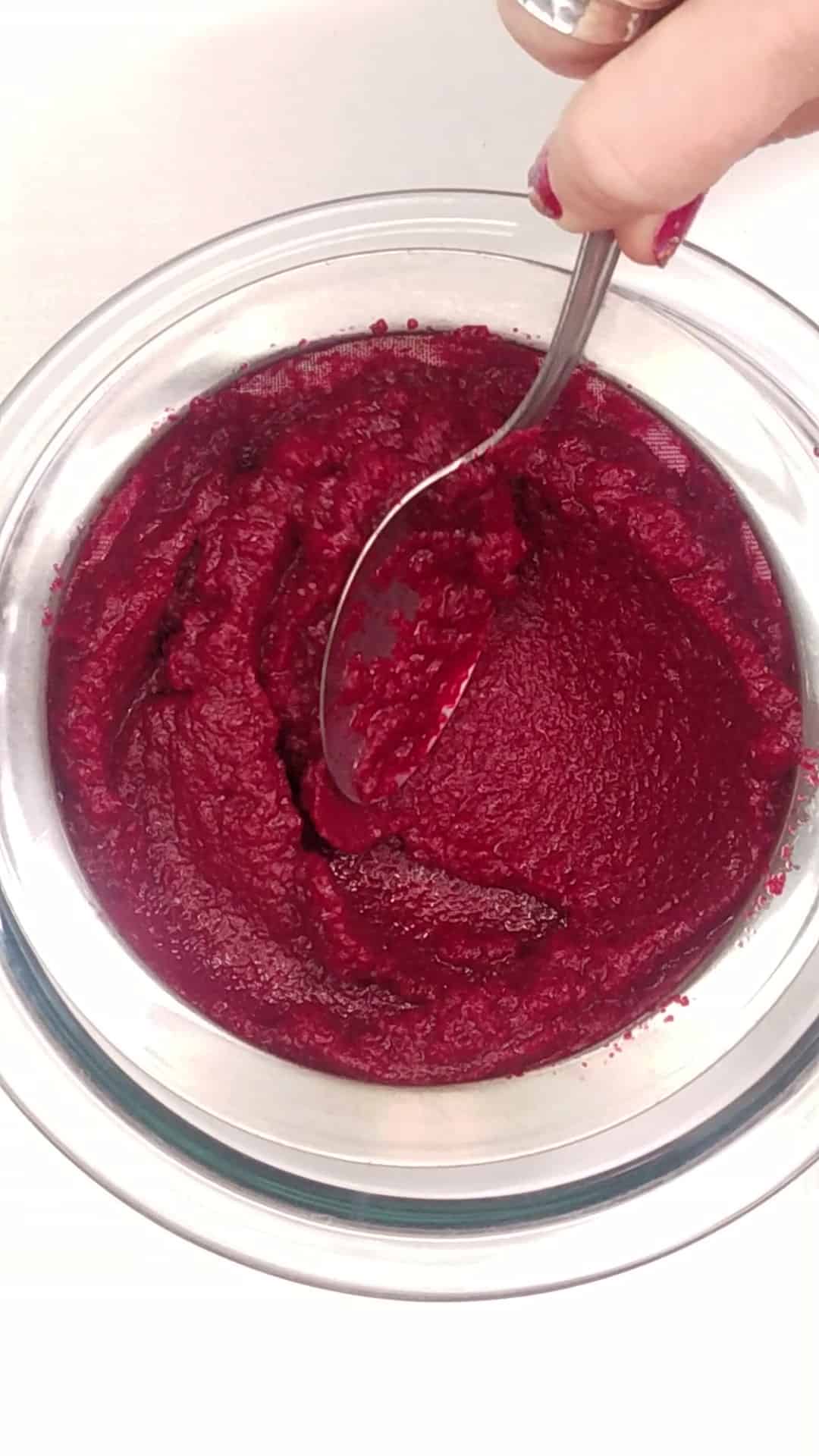
- Prepare the tapioca crepes: Add the tapioca flour to a medium bowl. Then, combine a pinch of salt and 3 tablespoons of the strained juice, mixing them well with your fingers until homogeneous and moistened but not to the point of forming a uniform liquid slurry. Place a spoonful of the tapioca mixture in one of your hands and press it tightly. If it forms a fairly moist yet well-set dough that can crumble when placed back into the bowl, the consistency is correct. TIP: However, if it gets too soft or liquid like a slurry, stir in a little bit of the tapioca flour. If too dry, combine just a little bit more of the juice.
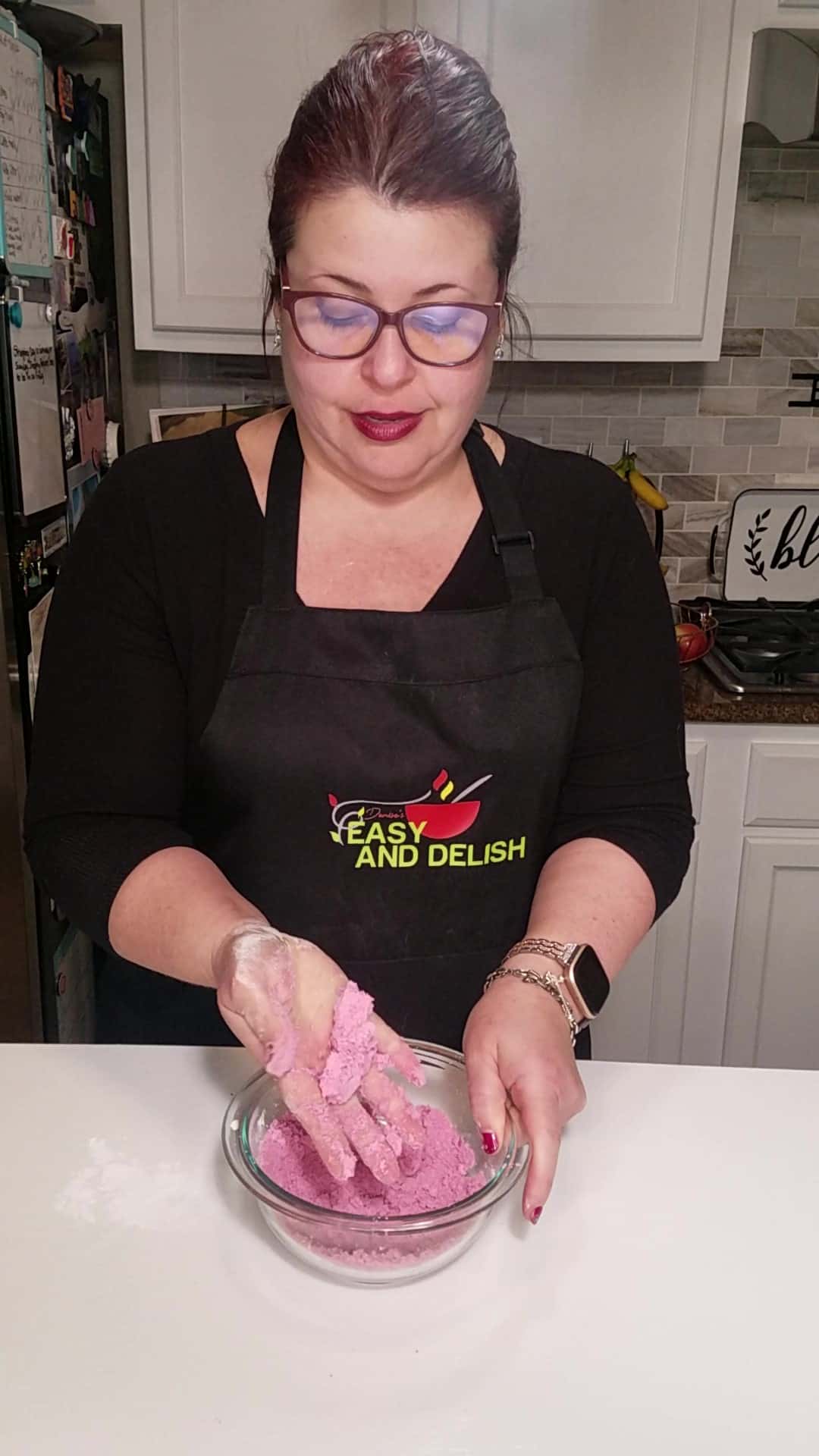
- Heat a small (5-½ inch diameter) non-stick skillet over medium-high heat for about 1-2 minutes, or until hot. Place the wet tapioca flour in a medium sieve. Use one hand to hold the sieve over the skillet and the other to press/rub the starch through the sieve into the skillet.
- Sieve and cook the Brazilian tapioca crepes: Sieve the starch in such a way that when it falls into the pan from the sieve it will form a uniform circle. Reduce the heat to medium.
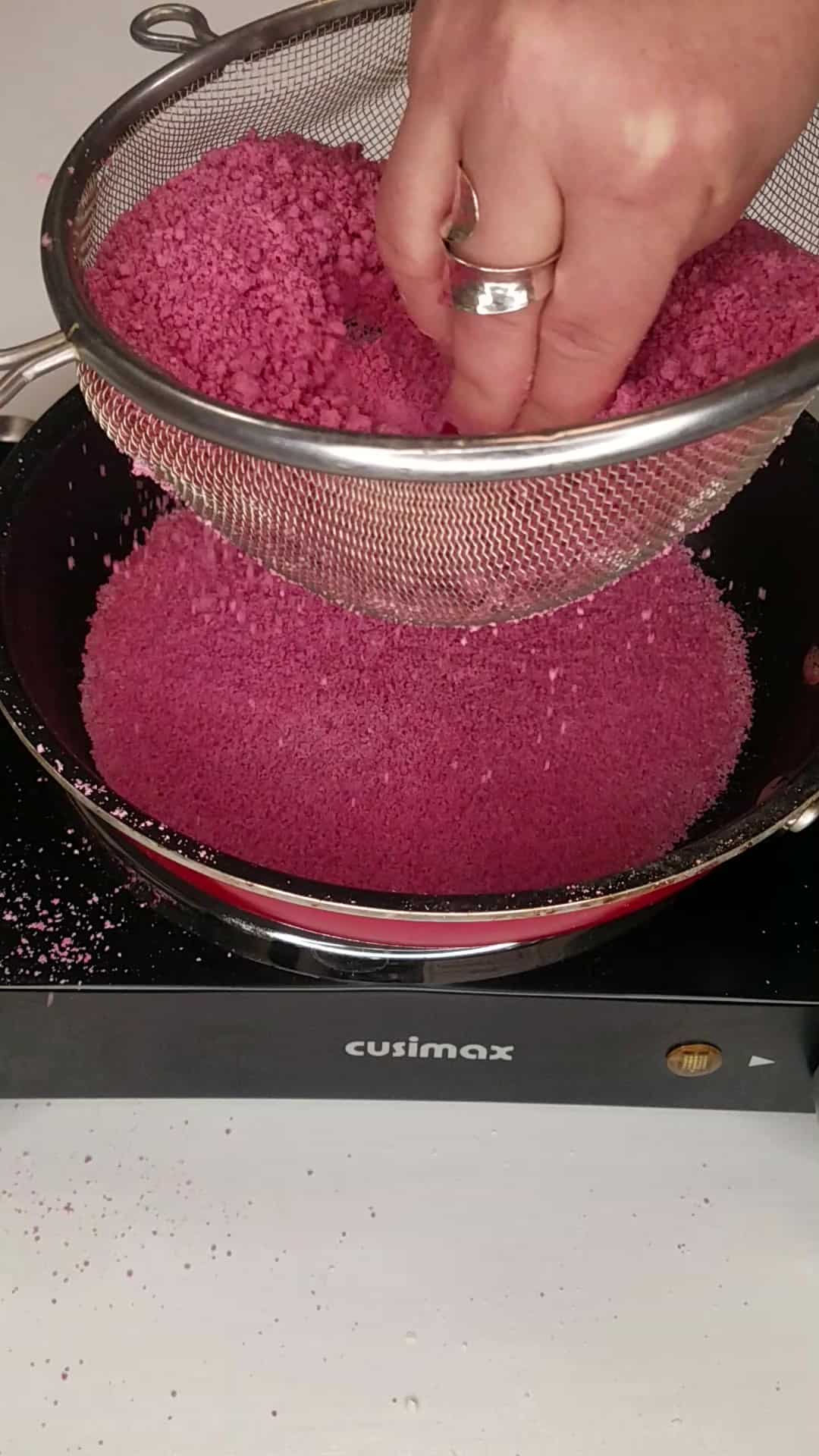
Let the heat bind and glue the grains so that the starch solidifies and forms a crepe/tortilla (pay close attention, because the crepe/tortilla will be ready in 15-30 seconds).
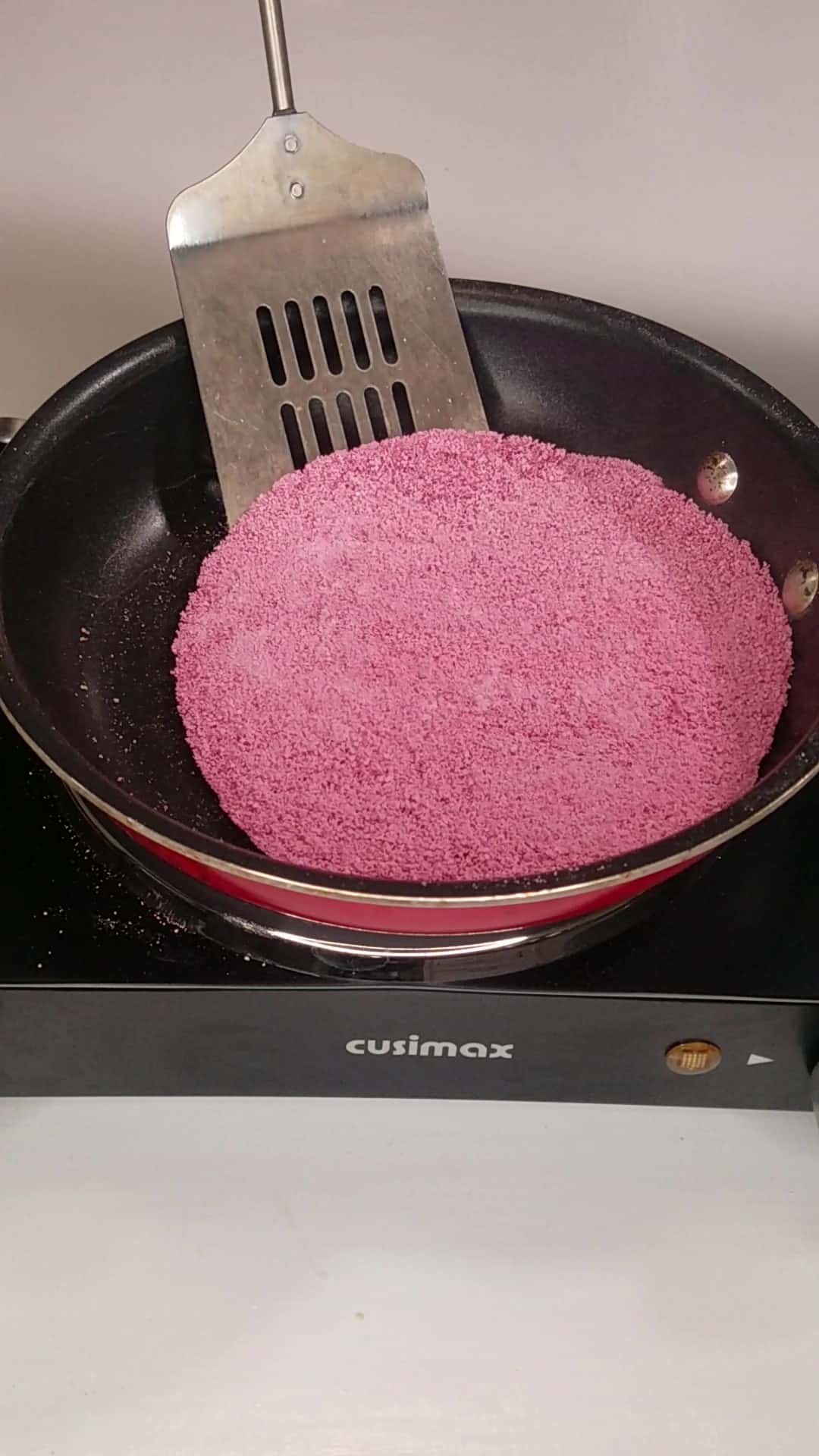
Make sure that the edges have as much starch as the center- that way, the edges will not be prone to breakage. Flip the tapioca over using a metal spatula with thin edges and cook very briefly on the other side, or simply slide the tapioca crepe onto a plate.
- Fill them: Place on a plate, spread butter on one of the sides of the tapioca crepe, and fill with any filling of your choice such as chicken or tuna salad (with less mayo), scrambled eggs, melted cheese, shredded meats, Nutella with sliced strawberries, or peanut butter with sliced bananas, etc. TIP: If the filling gets too wet, it will make the crepe break apart.
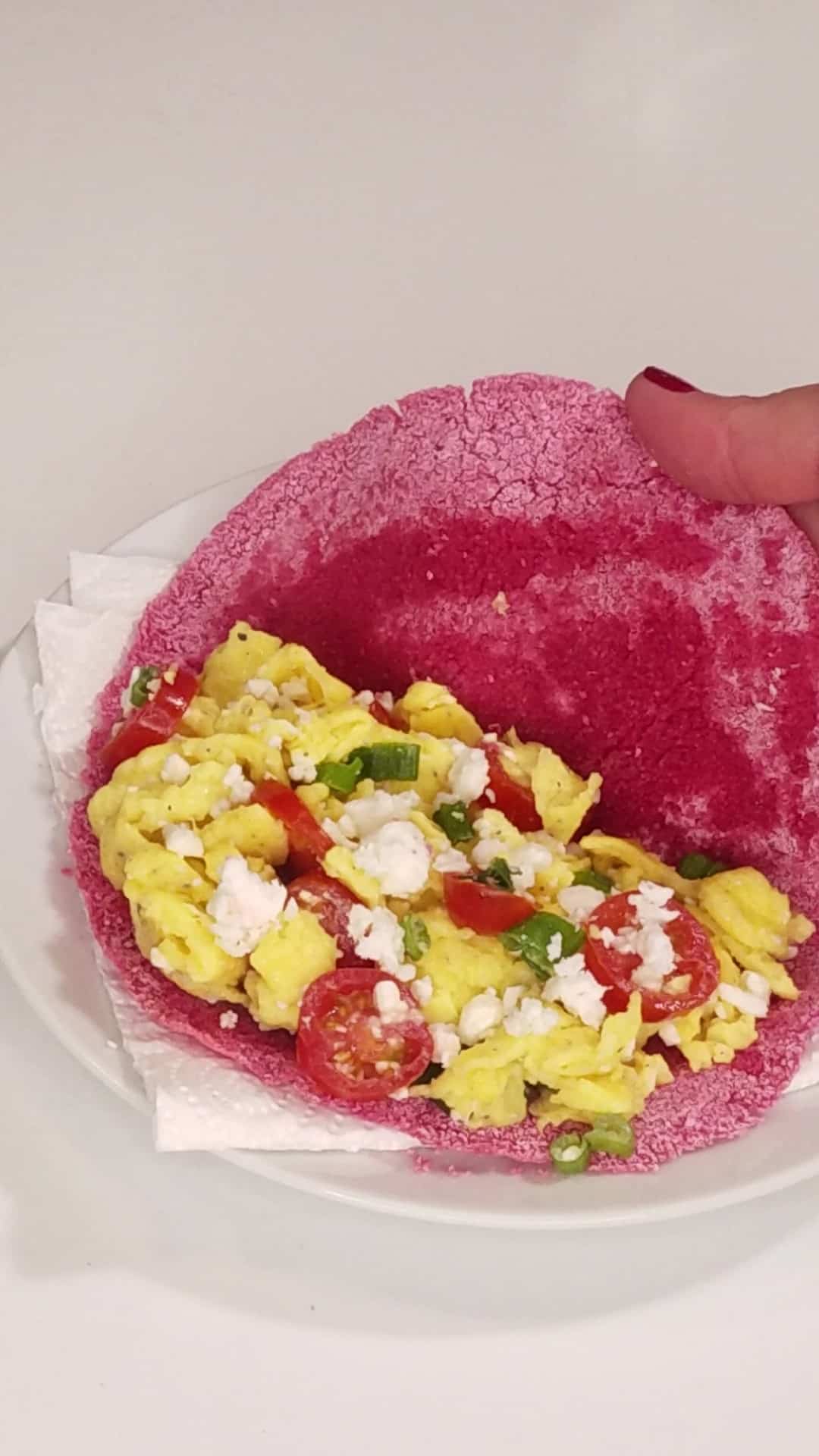
- If filling with shredded mozzarella cheese, place the tapioca crepe on a plate, spread butter on both sides, fill with shredded cheese, roll the tapioca crepes up (like an enchilada), or simply fold it like a taco, return to the skillet over medium heat, and let the cheese melt. Remove from heat and serve immediately.
NOTE: Between making one tapioca crepe and the next, please remove the skillet from heat and wipe both the bottom and sides of the skillet clean with a wad of paper towels (being careful to not burn yourself), so that the next tapioca won't be browned by the singed leftover grains of starch.
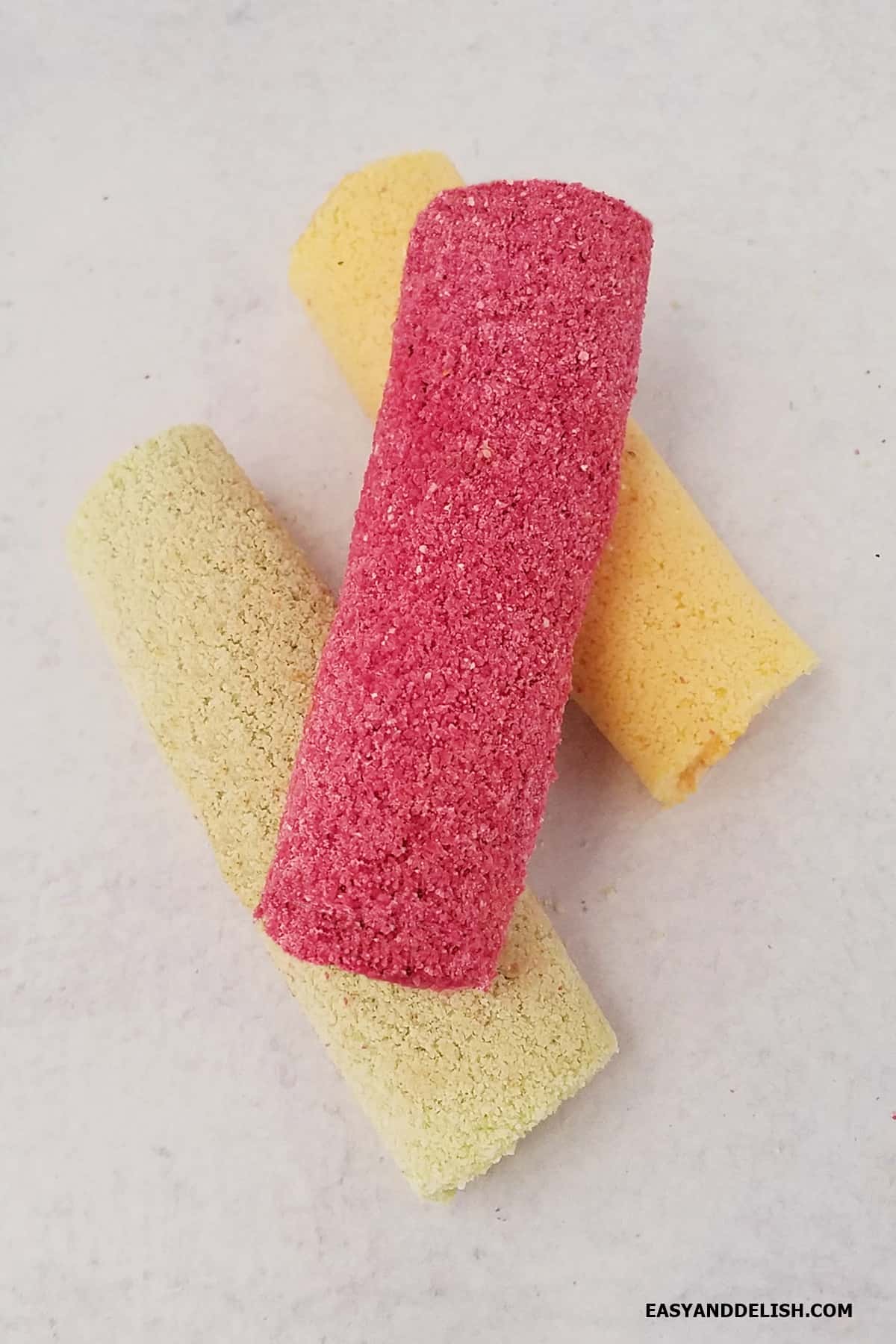
MEAL PREP AHEAD TIP: Store any leftover juice for later use in a Mason jar for up to 3-4 days in the fridge. Or, mix each juice with enough tapioca flour and store each in a separate airtight container in the fridge for up to 7 days though.
Watch me making colorful tapioca crepes with beet juice (pink tapioca crepes), carrot and turmeric juice (yellow tapioca crepes), and spinach juice (green tapioca crepes).
It's so good to know that I can use tapioca flour to make tapioca. I am Brazilian and find the sour tapioca is very hard. Thanks for teaching us how to make this using one that we can find anywhere in the US. Love your recipes!" -- Lucia
Ingredients and Substitutions
To make colorful tapioca crepes, you'll need:
Vegetable Juice
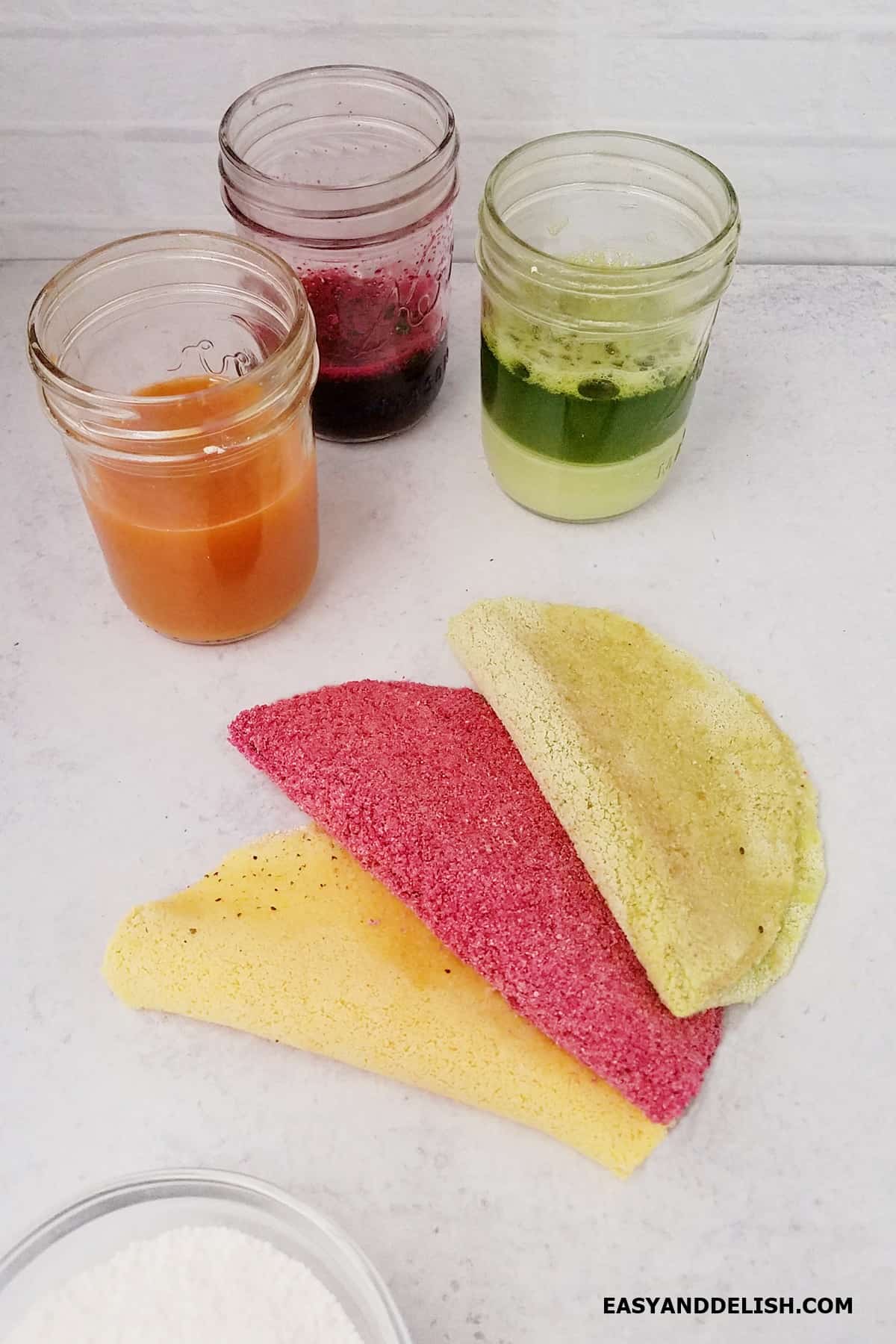
- ¾ cup water (if you prefer to make your tapioca crepe white, use water only and skip making any vegetable juice).
- 1 cup baby spinach, fully packed -- chopped kale (for the GREEN crepes). Or, peeled chopped beets (pink tapioca crepes) or baby carrots (yellow crepes). For making brown crepes, use prepared black coffee (liquid), unsweetened.
- A pinch of ground turmeric, optional (only if using carrots)
Tapioca Crepes
- ½ cup tapioca flour (If using pre-hydrated tapioca flour, you'll need less juice, about 1 to 1 ½ tablespoons, to color your crepes. Alternatively, you can swap tapioca flour with sour starch, or polvilho azedo, a by-product of the cassava root)
- A pinch of table salt
Fillings for Brazilian Tapioca Crepes
The possibilities are endless. You can fill your tapioca crepes with pretty much any savory or sweet filling. Here are are few suggestions:
Savory fillings
- Tuna salad
- Chicken salad
- Melted cheese (use any melting cheese such as mozzarella, cheddar, Pepper Jack, etc)
- Scrambled eggs
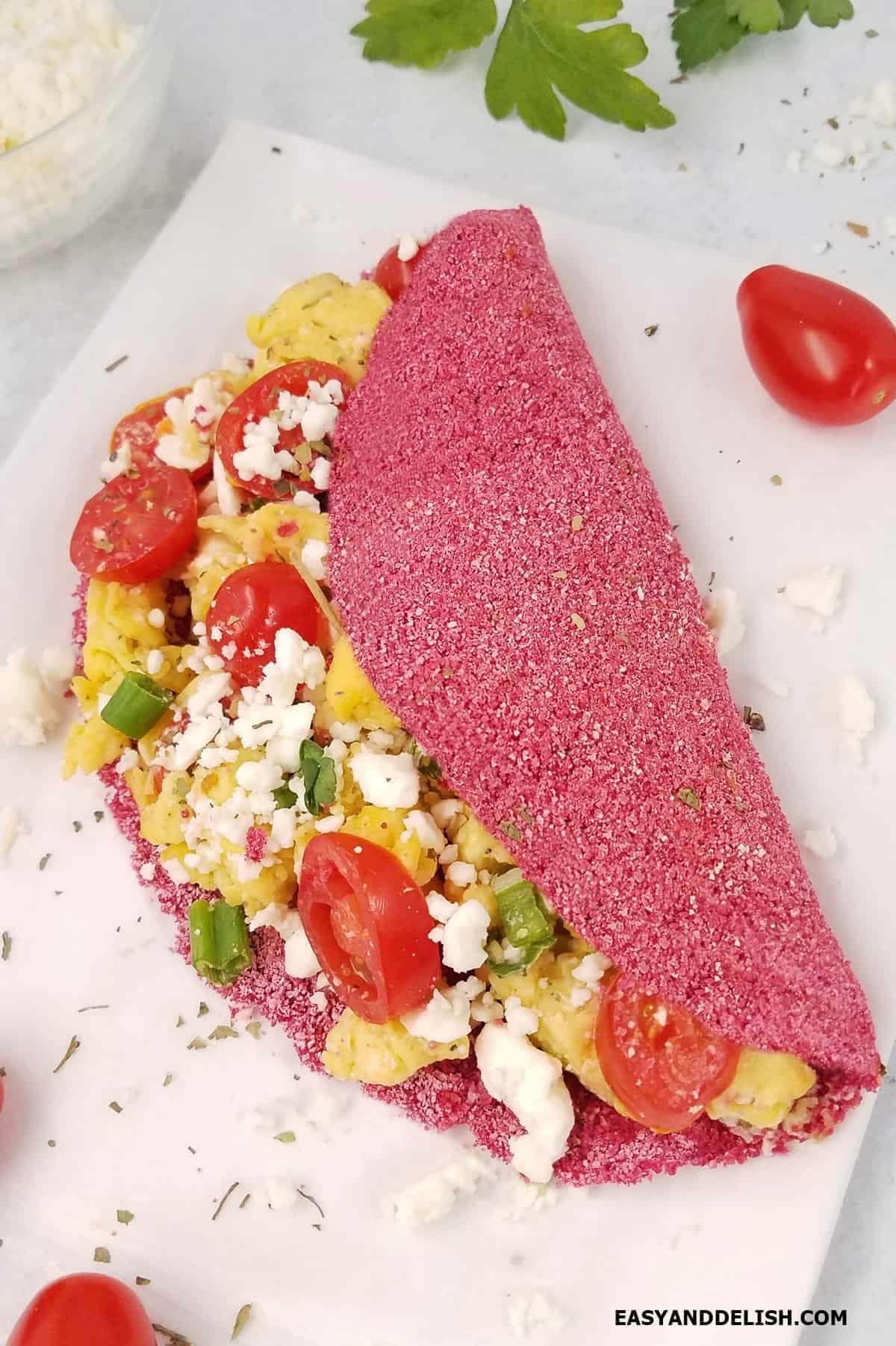
Sweet fillings
- Peanut butter and sliced bananas with a drizzle of honey and some chopped nuts
- Nutella and sliced or chopped strawberries
NOTE: Whatever filling you go for, make sure it isn't too wet; otherwise, it will make your tapioca crepes break apart. To prevent that, I place a bed of mixed greens or fresh baby spinach under my chicken or tuna salad when filling my Brazilian tapioca.
Brazilian Tapioca Recipe
To make Brazilian tapioca crepes you'll simply need tapioca flour, water (coffee or juice), and salt. Then, follow our tapioca recipe from a Brazilian native.
It's gluten-free, dairy-free, vegan, and paleo. You can prepare it in about 10 minutes and cook it in a few seconds.
You can serve them with coffee, tea, soda, milk tea with brown sugar boba, and more.
If you love crepes, you'll be delighted to try these naturally gluten-free, vegan, paleo tapioca crepes.
You can make them with water, resulting in a white tapioca crepe (the most common type). Or, you can make them with juice, like we did, rendering colorful tapioca crepes.
Moreover, you can fill them with melted cheese, scrambled eggs, shredded beef with sauteed onions, chicken or tuna salad, etc.
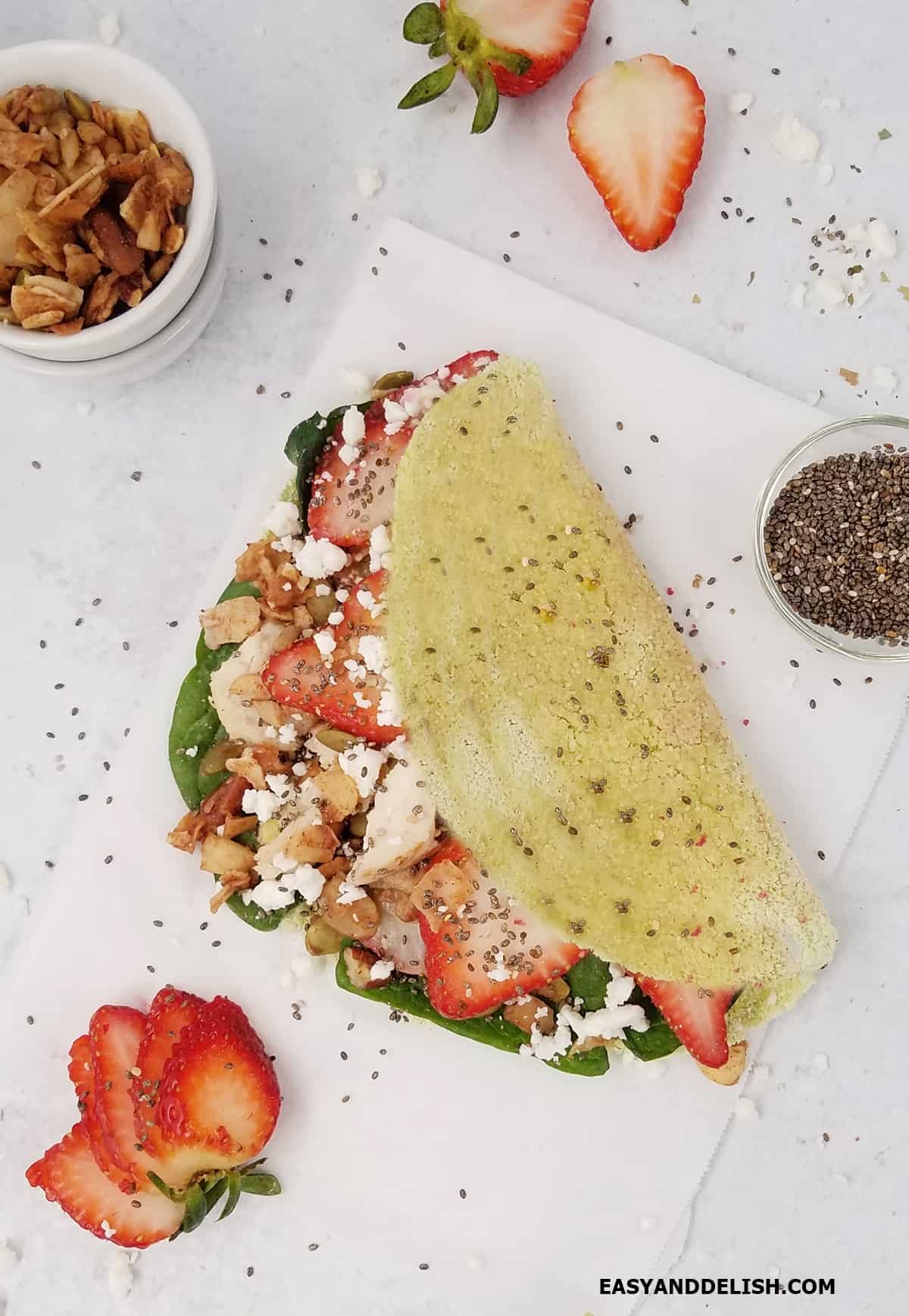
Pro Tips for Making Tapioca Crepes
- Make sure to mix in just enough liquid (water or vegetable juice) with the tapioca flour to obtain a fairly moist yet well-set dough that can crumble easily. Test the correct consistency by placing a spoonful of the mixture in one of your hands and pressing it tightly to form a dough cylinder or ball.
- Cook the Brazilian tapioca crepes in a nonstick skillet; otherwise, the moistened dough will stick to the bottom of the pan.
- Preheat the skillet over medium-high heat before start cooking your Brazilian crepes. Then, reduce the heat to medium when cooking them.
- Use a metal spatula with thin edges to flip the Brazilian crepes.
- Use a fine-mesh strainer to strain the tapioca flour mixture in such a way that when it falls into the hot skillet from the sieve it will form a uniform circle.
- Let the heat bind and glue the grains so that the tapioca starch solidifies and forms a crepe/tortilla (pay close attention, because the crepe/tortilla will be ready in 15-30 seconds).
- Make sure that the edges have as much starch as the center- that way, the edges will not be prone to breakage.
- Before making another tapioca wrap, remove the skillet from heat and wipe both the bottom and sides of the skillet clean with a crumpled paper towel so that the next tapioca won't be browned by the singed leftover grains of starch.
FAQs
I am from Pernambuco state in the Northeastern region, where tapioca is a traditional dish that we make with tapioca flour. It is not a pudding, it is a gluten-free crepe that we often serve at breakfast time either with butter or filled with cheese, or with a variety of savory or sweet fillings at afternoon snack time.
Mostly yes! It's a great cheap source of carbohydrates and therefore, energy, containing a few vitamins and minerals, like iron and potassium, and no fat. Most people may consume it in moderation. Because it is high-glycemic, it may not be suitable for those with diabetes.
Traditional Brazilian tapioca crepes call for a mixture of tapioca flour, water, and salt. However, modern versions use strained fresh vegetable juice (e.g. carrots, beets, or kale) instead to color the tapioca flour.
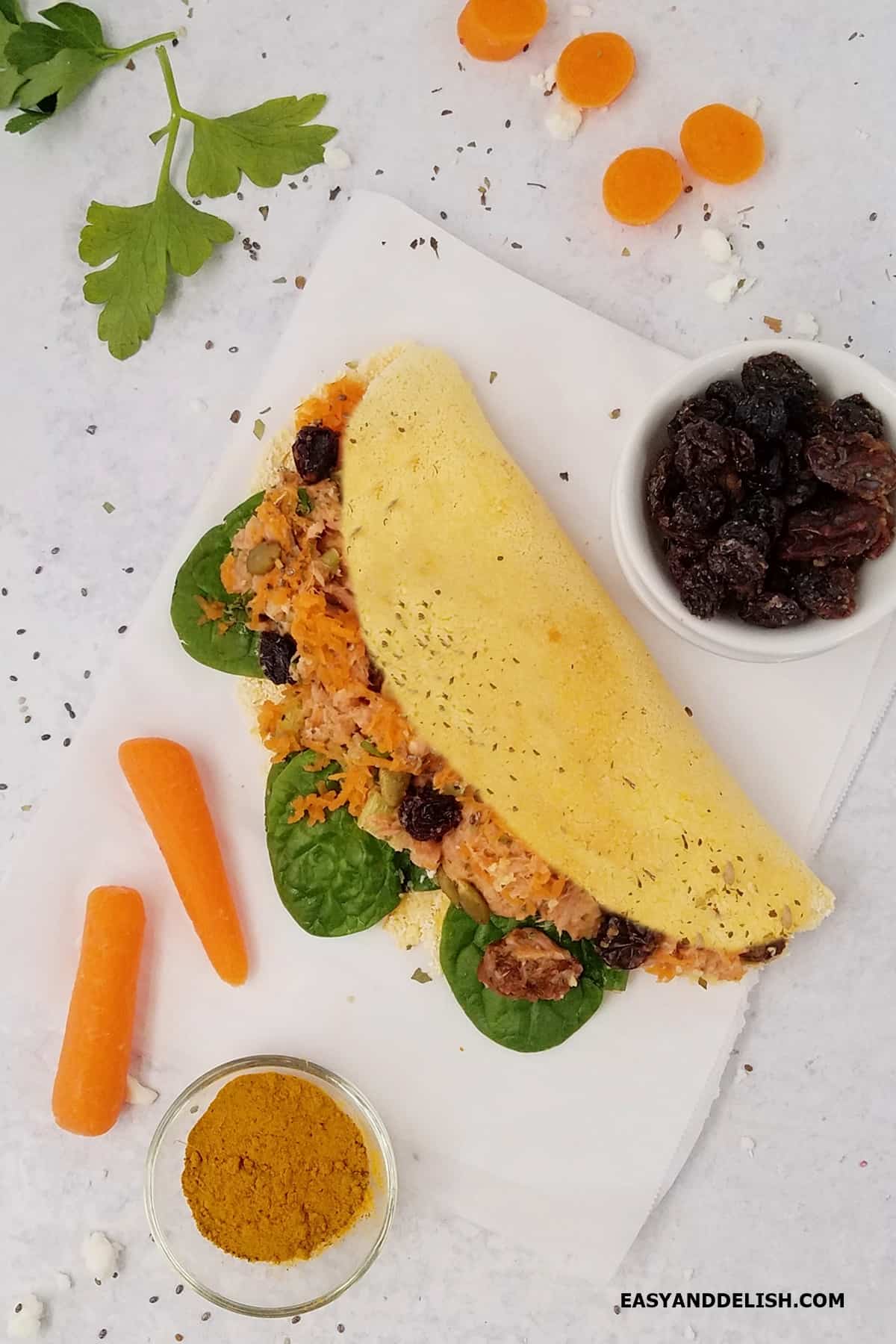
How to Store
- Brazilian tapioca crepes are better eaten right away. Otherwise, they will harden after cooling.
- After cooling, store non-filled tapioca crepes in sealable plastic bags (with air removed as much as possible) or in an airtight container at room temperature for up to 24 hours. You may use them as canapés (called beiju). But be aware they won’t be soft like when they were first made. I am not a fan of beiju (hardened tapiocas) but you can try them and form your own opinion.
Other Brazilian Tapioca Recipes
Besides this Brazilian tapioca recipe, check out these other recipes with tapioca flour:
- Tapioca cake
- Brazilian tapioca pudding
- Farofa recipe
- Gluten-free waffles
- Gluten-free breadsticks
- Brazilian cheese bread
- Cheese rolls
- Bacon and cheese hot pockets
PIN AND ENJOY!
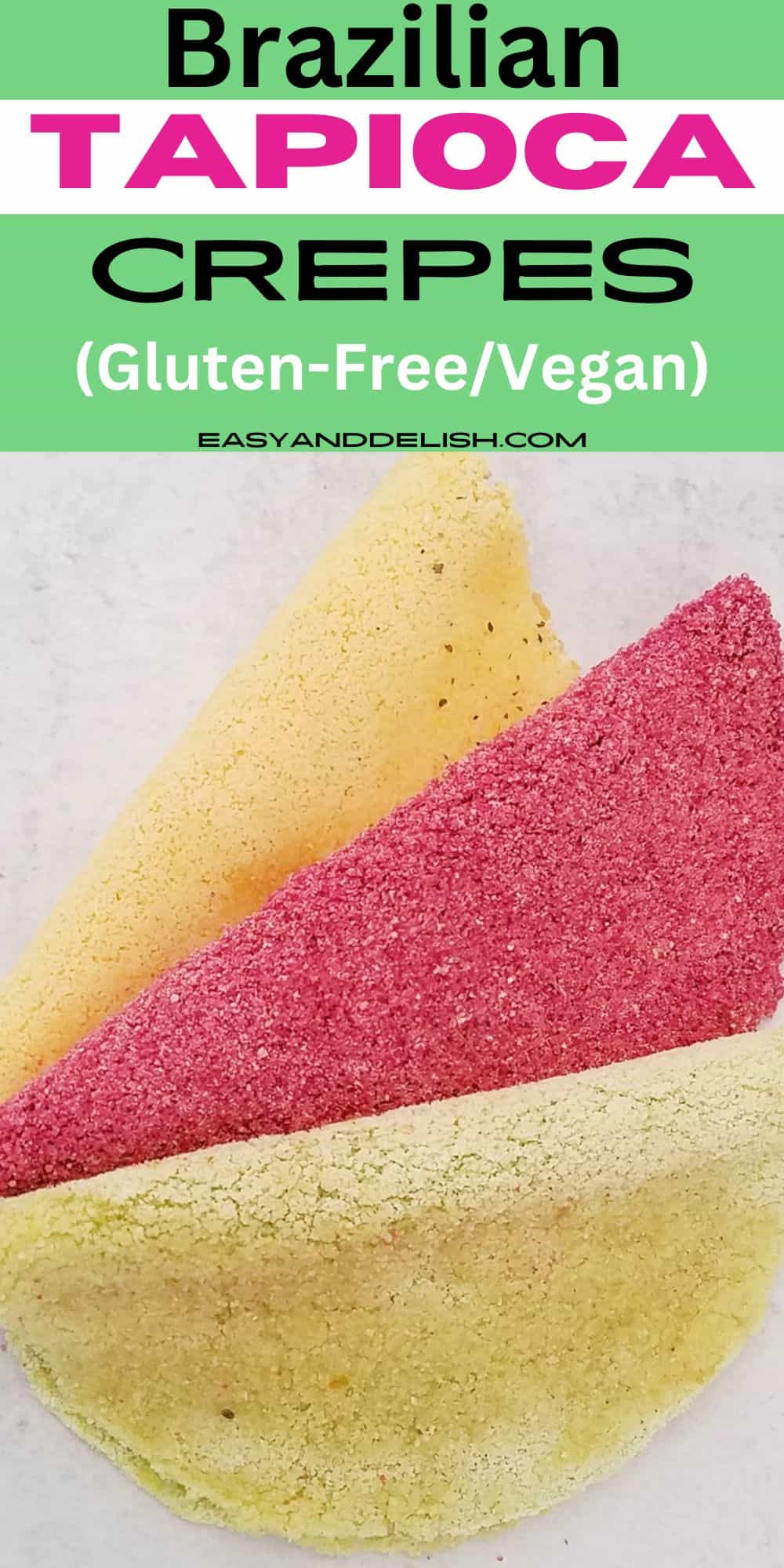
Brazilian Tapioca Crepes (3 Colors)
Equipment
- 1 small nostick skillet
- 1 metal spatula with thin edges
- 1 Medium mixing bowl
- 1 blender ONLY if coloring the tapioca crepes with juice
Ingredients
For the Vegetable Juice
- ¾ cup water if you prefer to make your tapioca crepe white, use water only and skip making any vegetable juice.
- 1 cup baby spinach fully packed -- chopped kale (for the GREEN crepes). Or, peeled chopped beets (pink tapioca crepes) or baby carrots (yellow crepes). For making brown crepes, use prepared black coffee (liquid), unsweetened.
- A pinch of ground turmeric optional (only if using carrots)
For the Tapioca Crepes
- ½ cup tapioca flour If using pre-hydrated tapioca flour, you'll need less juice, about 1 to 1 ½ tablespoons, to color your crepes. Alternatively, you can swap tapioca flour with sour starch, or polvilho azedo, a by-product of the cassava root
- A pinch of table salt
Instructions
- Prepare the juice to color the tapioca crepes: In a blender, blend one of the vegetables (spinach, beets, or carrots) with water until smooth. Using a fine-mesh sieve, strain the liquid and discard the pulp (or use it to make something else). Reserve the strained juice. NOTE: If you prefer to prepare the most common type of tapioca which is white, simply use water instead of juice. The vegetable juices won't flavor the crepes. They only color the tapioca flour with natural food coloring.
- Prepare the tapioca crepes: Add the tapioca flour to a medium bowl. Then, combine a pinch of salt and 3 tablespoons of the strained juice, mixing them well with your fingers until homogeneous and moistened but not to the point of forming a uniform liquid slurry.
- Place a spoonful of the tapioca mixture in one of your hands and press it tightly. If it forms a fairly moist yet well-set dough that can crumble when placed back into the bowl, the consistency is correct. TIP: However, if it gets too soft or liquid like a slurry, stir in a little bit of the tapioca flour. If too dry, combine just a little bit more of the juice.
- Sieve the tapioca flour mixture and cook: Heat a small (5-½ inch diameter) non-stick skillet over medium-high heat for about 1-2 minutes or until hot. Place the wet tapioca flour in a medium sieve. Use one hand to hold the sieve over the skillet and the other to press/rub the starch through the sieve into the skillet.
- Sieve the starch in such a way that when it falls into the pan from the sieve it will form a uniform circle. Reduce the heat to medium.
- Let the heat bind and glue the grains so that the starch solidifies and forms a crepe/tortilla (pay close attention, because the crepe/tortilla will be ready in 15-30 seconds).
- Make sure that the edges have as much starch as the center- that way, the edges will not be prone to breakage. Flip the tapioca over using a metal spatula with thin edges and cook very briefly on the other side, or simply slide the tapioca crepe onto a plate.
- Fill the Brazilian crepes: Place on a plate, spread butter on one of the sides of the tapioca crepe, and fill with any filling of your choice such as chicken or tuna salad (with less mayo), scrambled eggs, melted cheese, shredded meats, Nutella with sliced strawberries, or peanut butter with sliced bananas, etc. TIP: If the filling is too wet, it will make the crepe break apart.
- If filling with shredded mozzarella cheese, place the tapioca crepe on a plate, spread butter on both sides, fill with shredded cheese, roll the tapioca crepes up (like an enchilada), or simply fold it like a taco, return to the skillet over medium heat, and let the cheese melt. Remove from heat and serve immediately.
- NOTE: Between making one tapioca crepe and the next, please remove the skillet from heat and wipe both the bottom and sides of the skillet clean with a wad of paper towels (being careful to not burn yourself), so that the next tapioca won't be browned by the singed leftover grains of starch.
- MEAL PREP AHEAD TIP: Store any leftover juice for later use in a Mason jar for up to 3-4 days in the fridge. Or, mix each juice with enough tapioca flour and store each in a separate airtight container in the fridge for up to 7 days.
Recipe Video
Recipe Notes
- Polvilho Azedo/ Sour Starch/ Almidón Agrio (alternative tapioca starch) is available at local Latin Markets, Brazilian Stores, and online. It is naturally gluten-free.
- Brazilian tapioca crepes are better eaten right away. Otherwise, they will harden after cooling.
- Once cooled, the non-filled tapioca crepes may be stored in sealable plastic bags (with air removed as much as possible) or in an airtight container at room temperature for up to one day. You may use them as canapés (called beiju). But be aware they won’t be soft like when they were first made. I am not fond of beiju (hardened tapiocas) but you are welcome to form your own opinion.
- Make sure to mix in just enough liquid (water or vegetable juice) with the tapioca flour to obtain a fairly moist yet well-set dough that can crumble easily. Test the correct consistency by placing a spoonful of the mixture in one of your hands and pressing it tightly to form a dough cylinder or ball.
- Cook the Brazilian tapioca crepes in a nonstick skillet; otherwise, the moistened dough will stick to the bottom of the pan.
- Preheat the skillet over medium-high heat before start cooking your Brazilian crepes. Then, reduce the heat to medium when cooking them.
- Use a metal spatula with thin edges to flip the Brazilian crepes.
- Use a fine-mesh strainer to strain the tapioca flour mixture in such a way that when it falls into the hot skillet from the sieve it will form a uniform circle.
- Let the heat bind and glue the grains so that the tapioca starch solidifies and forms a crepe/tortilla (pay close attention, because the crepe/tortilla will be ready in 15-30 seconds).
- Make sure that the edges have as much starch as the center- that way, the edges will not be prone to breakage.
- Before making another tapioca wrap, remove the skillet from heat and wipe both the bottom and sides of the skillet clean with a crumpled paper towel so that the next tapioca won't be browned by the singed leftover grains of starch.
- Tuna salad
- Chicken salad
- Melted cheese (use any melting cheese such as mozzarella, cheddar, Pepper Jack, etc)
- Scrambled eggs
- Dulce de leche spread or peanut butter with sliced bananas, a drizzle of honey, and some chopped nuts
- Nutella and sliced or chopped strawberries
Nutrition
** Nutrition labels on easyanddelish.com are for educational purposes only. This info is provided as a courtesy and is only an estimate, since the nutrition content of recipes can vary based on ingredient brand or source, portion sizes, recipe changes/variations, and other factors. We suggest making your own calculations using your preferred calculator, based on which ingredients you use, or consulting with a registered dietitian to determine nutritional values more precisely.
Please note that health-focused and diet information provided on easyanddelish.com is for educational purposes and does not constitute medical advice, nor is it intended to diagnose, treat, cure, or prevent disease. Consult with your doctor or other qualified health professional prior to initiating any significant change in your diet or exercise regimen, or for any other issue necessitating medical advice.
This post was first published on May 2, 2013.
Brazilian Breakfast
I can't talk about Brazilian tapioca without describing Breakfast in Brazil, the meal that features tapioca crepes more often.
I will start by saying that breakfast is served only once per day, usually between 6 and 8 am.
Practically speaking, in Brazil there is no such thing as brunch.
Most of the time Brazilians eat breakfast at home, or sometimes have a light breakfast at the padaria (bakery) on the weekends.
Since the majority of restaurants there serve only lunch and/or dinner, up until recently there was no such thing as going out for breakfast.
But what if we are traveling within Brazil, what do we do about breakfast then? No problem!
Hotels normally serve a plentiful breakfast, which is included in the hotel fee though.
I can guarantee that neither you nor I will go hungry down there. 🙂
Brazilian breakfasts also tend to be on the lighter side, since lunch is our main meal.
So, if you are staying at someone's house in Brazil, generally do not expect to see pancakes or waffles.
In addition, there won't be cooked meats such as bacon and sausage, hash browns, or omelette on your plate...
Well, not even a variety of cereals.
In general, traditional Brazilian breakfast includes the following:
- a small loaf of French bread or toast,
- butter,
- scrambled, hard-boiled eggs, or sunny-side up eggs.
- fruit (usually papaya),
- a cup of black coffee with or without milk, or a glass of juice (orange juice being the most popular),
- Sometimes hot cocoa or fruit smoothies (papaya, banana, or avocado smoothie).
There may also be oatmeal (papa de aveia), yogurt, jams, and sliced or spreadable cheeses, including a mildly salty, silky-textured, spreadable cheese sold in glass jars and eaten on bread called requeijão or Brazilian cream cheese.

Further, you may encounter cold cuts (deli ham, smoked turkey, or salami) and coffee cakes such as orange, plain Brazilian carrot cake without topping, or cornmeal cake (bolo de fubá).
Cereal is not quite as popular, but some Brazilians do like granola.
In hotels, depending on how many stars they have, the options can be endless.
Many items typical of an American breakfast are available there, and/or several regional dishes.
The wide selection of fruit available at the breakfast stations of high-end hotels impresses tourists and has to be experienced.
In padarias (bakeries), the most popular items are café pingado (a cup of coffee with a touch of milk) and pão na chapa (half loaves of French bread toasted with butter on a hot griddle) though.
You may also find misto quente (grilled ham-and-cheese-sandwich).
But that is not all!
Since Brazil is such a large country and has many different regional cuisines, depending on the region or even the state, the breakfast menu may include:
- Some local delicacies such as corn couscous (cuscuz de milho), boiled cassava or inhame (true yam),
- Pão de queijo
- Milk curd (coalhada),
- Mate tea (chá mate),
- Chipas (a cousin ofpão de queijo)
- Biscoito de nata recipe, German coffee cakes such as this apple crumb cake (cuca de maçã) and others, and of course, Brazilian tapioca crepes with butter or filled with cheese.



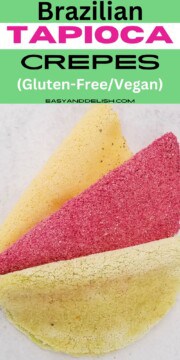
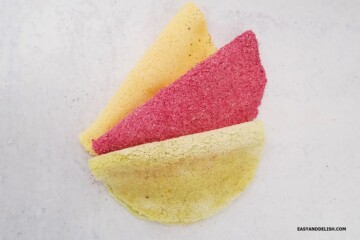
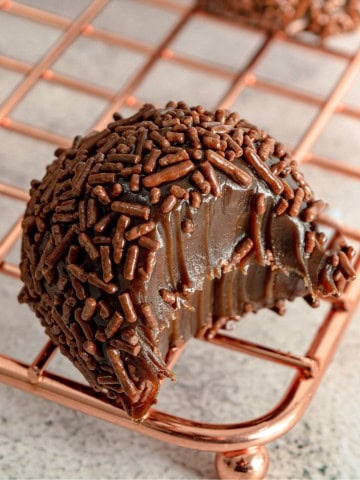


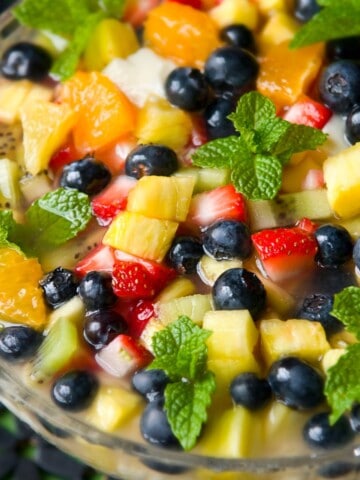
Saskia says
Hi Denise! Are you using prehydrated tapioca flour in this recipe, or is it regular goma de tapioca and it only needs some spoonfuls of water sprinkled on top? If it is prehydrated, could you share a (hopefully relatively easy) way to hydrate goma de tapioca so that it becomes suitable to make pancakes? Thanks!
Denise Browning says
Hi Saskia! No, for this recipe I am not using the pre-hydrated tapioca flour or 'goma de tapioca hidratada'. The amount of water used in the recipe is only enough to make the tapioca flour stick and form the crepes. I prefer to hydrate the tapioca flour right before making the crepes because I don't make them often anymore. But if you make tapioca crepes often, you can prehydrate the flour by doing the following: 1. Place tapioca flour into a large mixing bowl and put in enough water to completely cover the tapioca flour by 1-inch depth. 2. Cover bowl with a clean kitchen towel and let sit for about 5 minutes. Then Pour the mixture into the kitchen towel and squeeze well to remove excess moisture. 3. Next, place the "massa" ou "dough" onto a baking sheet and try to break the "dough" apart. Place the baking sheet uncovered in the refrigerator for about 12 hours. 4. To achieve the consistency of a prehydrated goma de tapioca, you can use a food process to process the goma and store into an airtight container or a Ziploc bag (make sure to squeeze out most of the air). Keep refrigerated for up to 2 weeks. Or you can freeze for up to 2 months. I hope this helps!
Brian says
This site was... how do you say it? Relevant!! Finally I have found something that helped
me. Thanks for the tapioca crepes recipe. They were very delicious. Cheers!
Mike says
Such a delicious recipe. I had no idea crepes could be made from tapioca flour. Living and learning. I intend to try those crepes with other filling too, thanks.
Lucia says
It's so good to know that I can use tapioca flour to make tapioca. I am Brazilian and find the sour tapioca is very hard. Thanks for teaching us how to make this using one that we can find anywhere in the US. Love your recipes!
Cristina says
Muito obrigada Denise!
Um Feliz Ano Novo p vc!
Denise Browning says
De nada, Cristina! Pra vc e sua familia também.
Qualquer dúvida, é só perguntar!
Cristina says
Oi Denise,
Q blog maravilhoso!
Mas, e ai' se eu fizer com polvilho doce? sai ruim?
Bjs!
Denise Browning says
Oi, Cristina!
Você poderá tentar fazer com polvilho doce. Eu fiz uma vez e saiu direitinho mas terá um pouco mais de trabalho e também terá que molhar o polvilho doce de pouco em pouco até ficar um pouco enpelotado (lumpy). Deixe descansar por uns 5 minutos e depois passe pela peneira com ajuda de uma das mãos seguindo o mesmo procedimento descrita na receita aqui. Dependendo do recheio, será necessário ou não colocar sal na massa da tapioca antes de fazer. Quando eu receheio com manteiga salgada e queijo (porque já é também salgado), eu não coloco sal na minha massa. Mas aí depende da sua preferência.
Esperoq eu dê tudo certo com o polvilho doce. Um abraço!!!
Monica says
Oi Denise,
Essa farinha pode ser encontrada em mercado latino????ou so posso usar esse encontrado no Amazon???
Denise Browning says
Olá, Monica! Bem-vinda!
O sour starch (ou polvilho azedo) pode ser encontrado em Brazilian markets ou na Amazon.com. Há outras lojas de produtos brasileiros online que também vende. Alguns Latin markets também vende mas não todos. Lembra que o polvilho azedo é diferente do polvilho doce (ou tapioca starch). Quando você for comprar, compra o sour starch pois é muito mais fácil de fazer a tapioca e o gosto é muito similar. Se você tiver alguma dúvida, é só perguntar. Um abraço!
Aditya says
Hii !! first thing first, thank you very much Denise for this recipe, cassava flour is also common here in Indonesia so think i'll give it a try
i have a question btw, actually, i already tried this recipe but with Mocaf (modified cassava flour)but it failed, the flour didn't want to stick and instead it become brown because of the heat. i know it's not sour manioc starch (because i'm certain i cannot find the flour here in INA) but i was told that mocaf is also gluten-free and fermented (just like sour manioc starch). my question, is mocaf the right flour for this tapioca crepe ? thanks
Denise Browning says
Aditya: Thanks for trying this recipe. Unfortunately, I have never tried to make this recipe with mocaf. The fact that it is also fermented and gluten-free does not make mocaf suitable for this recipe. The sour manioc flour/starch has an elasticity given by the cassava and is high in starches. These might be elements that mocaf lacks. If tapioca flour is available in your country, you can use it to make this recipe. The only thing is you will have to soak the tapioca flour in water and leave at room temperature to evaporate the water, resulting in slightly wet flour. Then, you can make the tapioca crepes according to the directions of the recipe.